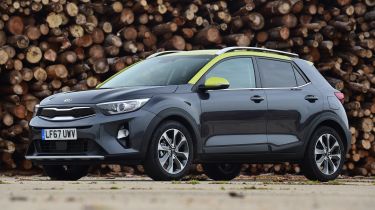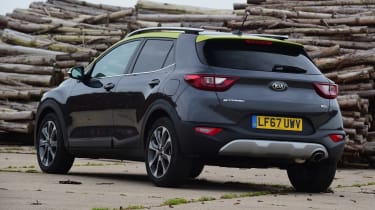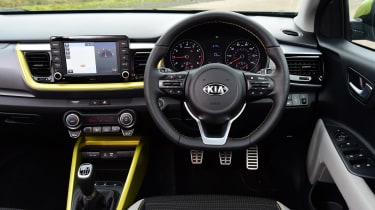Used Kia Stonic (Mk1, 2017-date) review
A full used buyer’s guide on the Kia Stonic covering the Stonic Mk1 (2017-date)
Verdict
Car makers have embraced supermini-sized crossovers with a vengeance, some with more success than others. You’ll pay a premium to buy a Stonic over a Rio, and whether you’re getting value for money is debatable, especially as the extra cash doesn’t raise the seating position by that much. The Stonic sits just 42mm higher than the Rio, but you do get more rugged looks and most importantly you also get all of the Kia traits that you’d expect: plenty of standard equipment, a cabin that’s built to a very high standard, plus a dash that’s very user-friendly with its intuitive design. There’s also the seven-year warranty – not that you’re likely to need it, thanks to Kia’s reputation for excellent reliability.
Superminis are the most popular cars across the whole of Europe. This has been the case for many years, but more recently buyers have been opting for SUVs of any size. When Nissan launched the original Juke in 2010, it kick-started a new class in the form of the B-segment SUV, and it didn’t take long for rival car makers to introduce their own variations on the theme.
One company that wasn’t in that first tranche was Kia, but by 2017 the Korean brand had joined the party with its Rio-derived Stonic. It’s a car that’s easy to like, even if it’s unexceptional in almost every way, and the Stonic is worth a closer look, even though its biggest threats come from other models in the Kia stable.
Used - available now

2024 KIA
Stonic
34,560 milesManualPetrol1.0L
Cash £11,387
2018 KIA
Stonic
59,908 milesManualPetrol1.0L
Cash £9,500
2024 KIA
Stonic
56,951 milesManualPetrol1.0L
Cash £9,900
2022 KIA
Stonic
25,215 milesManualPetrol1.0L
Cash £12,200Model covered
- Kia Stonic Mk1 (2017-date) - Supermini-based car blends Kia’s strengths with trendy SUV-style looks .
History
When the Stonic arrived in October 2017, buyers could choose between 118bhp turbocharged 1.0-litre or 98bhp non-turbo 1.4-litre petrol engines, while for diesel fans there was a 108bhp 1.6 CRDi option.
Initially there was a choice of 2 or First Edition trims, but within a few months Kia added 3 and 4 spec levels to the range. At first only a six-speed manual gearbox was offered, but by summer 2018 the 1.0 T-GDi engine could be specified with a seven-speed dual-clutch automatic transmission.
A revised Stonic went on sale in September 2020, only in 1.0 T-GDi form. The revamped model brought new driver-assistance systems, fresh paint colours, a larger, eight-inch display and mild-hybrid tech for all versions, apart from the entry-level 2. At the same time the 3 and 4 trims were replaced by GT-Line and GT-Line S.
Which one should I buy?
The 1.0 T-GDi is a great engine that does everything you need, but if you do a lot of miles it could be worth tracking down one of the rarer diesels. These combine muscle with economy, although they’re not very refined. The dual-clutch automatic transmission works well and so does the manual gearbox, so we wouldn’t steer you towards (or away from) one or the other.
Equipment levels are generous, with even the entry-level Stonic 2 featuring 17-inch alloy wheels (16-inch from the 2020 facelift), electrically folding door mirrors,
air-con, rear parking sensors, automatic headlights and a seven-inch display with DAB. The Stonic 3 adds navigation, a reversing camera, climate control and automatic wipers. The Stonic 4 also comes with heating for the front seats and steering wheel, keyless go and blind-spot warning.
Alternatives to the Kia Stonic
The Hyundai Kona shares a lot of tech and mechanicals with the Stonic, but its cabin isn’t quite as nice and the five-year warranty isn’t as generous. The SEAT Arona, Skoda Kamiq and Volkswagen T-Roc are all related and desirable for their build quality and usability. The Peugeot 2008 is plentiful and good value for money, as is the Renault Captur and its cousin, the Nissan Juke.
Other alternatives include the Citroen C3 Aircross, Mazda CX-3 and Ford Puma; the last of these is especially impressive. Alternatively, you could stick with Kia and opt for one of its other models. The Rio is the same size, while the Ceed and XCeed are a bit bigger but not significantly more expensive to buy or run. All three of these models are worthy of consideration.
What to look for
Specials
The Mixx and Maxx special editions from January 2018 and August 2019 were both only available with the 1.0 T-GDi engine.
FWD
The Stonic is only available with front-wheel drive. Kia claimed just eight per cent of buyers in the segment wanted four-wheel drive.
Safety kit
Lane Keep Assist and Forward Collision Avoidance were initially optional on the 2 trim, but these became standard from the 2020 facelift
Spare wheel
The Stonic comes with a tyre mobility kit rather than a spare wheel. You can buy a steel space saver from Kia for £163, complete with jack and brace.
Common faults
Kia has a well earned reputation for reliability, and the Stonic is no exception. While no car is immune from faults, there are no commonly reported issues for the SUV. Used examples should have some of their seven-year warranty left on them, too.
Interior
The Kia’s dashboard is simple to understand, with a touchscreen display that’s easy to navigate, and instrumentation that’s a model of clarity. Some of the materials disappoint, yet the build quality is impressive. The back seat is designed for three, but it’s heavily sculpted, so whoever sits in the middle will probably find it uncomfortable. The boot can hold 352 litres, which isn’t especially competitive; fold the seats and this rises to 1,155 litres, which is also generally behind rivals.
The eight-inch touchscreen infotainment is one of the best in this price range; it has sharp graphics, a clear layout and is quick and easy to use.
Prices
Running costs
All Stonics need maintenance every 12 months, but whereas there’s a 10,000-mile limit between check-ups for petrol models, diesels stretch this to 20,000 miles. Petrol Stonics run on a six-service cycle at £154, £196, £180, £259, £232 and £420. Diesel services alternate between Minor and Major. The former is priced at £75, whereas the latter is anywhere between £194 and £306, depending on which service it is.
All Stonic engines are chain-driven, so there are no cambelts to replace, but the brake fluid needs to be renewed every two years (included in the price of the service), while the coolant should be replaced every 10 years or 100,000 miles (the cost is also included in the service).
Recalls
Kia has a good record on safety-related recalls, and the company hasn’t issued any against the Stonic.
Driver Power owner satisfaction
The Stonic made its Driver Power new-car debut in the 2019 survey, in 20th place. It was 27th in 2020 and 34th in 2021; the surveys each ranked 75 cars. Kia should be as happy with those results, as owners are with their cars. Buyers rate their Stonics as above average in most areas; the low spots are ride quality and driving pleasure, but the ergonomics, servicing costs and interior quality all get a big thumbs up.










